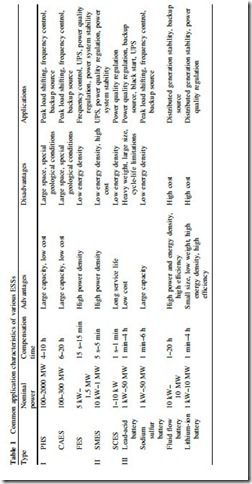Energy Storage Techniques
According to the specific principles, there are three main types of energy storage systems (ESSs): (i) Physical energy storage including pumped hydro storage (PHS), compressed air energy storage (CAES), and flywheel energy storage (FES);
(ii) Electromagnetic energy storage including superconducting magnetic energy storage (SMES), super-capacitor energy storage (SCES); (iii) Electrochemical energy storage including lead-acid, lithium-ion, sodium sulfur, and fluid flow battery energy storage, etc. Various types of energy storage devices are summarized in Table 1 as a guideline of technical specifications.
Physical energy storage is a kind of relatively mature and practical energy storage technology, which is limited by topographical and geological conditions to implement. The technology of electrochemical energy storage is evolving fastest so far, of which sodium sulfur battery, fluid flow battery, and lithium-ion battery technologies have made great breakthroughs in energy conversion efficiency, safety, and economy with increasingly industrialized applications. The energy conversion efficiency of sodium sulfur battery can reach 80 % with three times energy density as lead-acid battery with a much longer life cycle.
SMES devices can store the electric energy as electromagnetic energy in the superconducting inductor and release the stored energy if required. Comparing with other energy storage devices, SMES devices have fast response time, high power density, high energy storage efficiency, and long lifetime with little environmental pollution. The current focus on the applied superconducting technology for SMES has been moving to the industrial applications from the laboratory research stage, and the technology has been well verified for practical applications from small to large-scale units.
SMES applications are most commonly associated with the electrical power systems, such as considered for use in SGs recently, meanwhile other applications can also readily be found such as in electric vehicles (EVs), uninterruptible power supplies (UPSs), and power devices with special functions.

